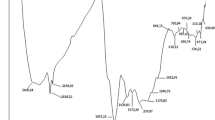Abstract
A mixed culture of Thiobacillus ferrooxidans, T. thiooxidans, and Leptospirillum ferrooxidans was used for inoculation of a sulphidic ore body for a bacterial in-situ stope-leaching experiment in the Ilba mine in Romania. The ore body was inoculated with 107 cells/g ore. Measurements at six main sites of the ore body indicated that microbial leaching was started by the inoculation. After about 8 weeks, sufficient microbial activity was measurable only in the upper third of the ore body. Due to the angle of incidence of the ore (75°), the leach liquor percolated only through the upper part leaving two-thirds humidified unsatisfactorily. The leach results, metal mobilization, indicated that by inoculation with the indigenous microorganisms efficient leaching was achieved. Metal output after 18 months of operation amounted to 10% of Cu and 78% of Zn. In the winter months energy for aeration and circulation was not available and this was reflected by reduced values for microbial activity, temperature, and daily metal output. The biological metal mobilisation after 18 months of operation was as active as at the beginning. Cu was mobilised predominantly by microbial leaching whereas Zn was leached mainly by chemical reactions. Both mechanisms contributed equally to iron output.
Similar content being viewed by others
References
Boreck DL, Lutzens WW, Speirer RA (1990) Ore leaching in underground stopes. Miner Res Eng 3:31–46
Brauckmann B, Poppe W, Beyer W, Lerche R, Steppke HD (1988) Investigations of increased biological in-situ leaching of the “Old Deposit” of the Preussag Rammelsberg ore mine. In: Norris PR, Kelly DP (eds) Biohydrometallurgy. Science and technology letters, Kew, pp 521–523
Burton C, Cowman S, Heffernan J, Thorne B (1983) In-situ bioleaching of sulphide ores at Avoca, Ireland. Part I. Development, characterization, and operation of a medium-scale (6000 t) experimental leach site. In: Rossi G, Torma AE (eds) Recent progress in biohydrometallurgy. Associazione Mineraria Sarda, Iglesias, Italy, pp 213–242
Derry R, Whittemore RG (1983) Modelling the in-situ bioleaching of zinc copper sulphide ore from Avoca, Ireland. In: Rossi G, Torma AE (eds) Recent progress in biohydrometallurgy. Associazione Mineraria Sarda, Iglesias, Italy, pp 243–264
Friedrich A (1991) Untersuchungen zur Überlebensrate ruhender Zellen stark acidophiler Bakterien. Diplom-thesis, University of Hamburg
Hallmann R (1991) Einfluss acidophiler chemoorganotropher Mikroorganismen auf die biologische Laugung. Diplom-thesis, University of Hamburg
Harrison AP Jr (1981) Acidiphilium cryptum gen. nov., sp. nov. heterotrophic bacterium from acidic mineral environments. Int J Syst Bacteriol 31:327–332
Hudson AW, van Arsdale GD (1923) Heap leaching at Bisbee, Arizona. AIME Trans 64:135–154
Hutchins SR, Davidson MS, Brierley JA, Brierley CL (1986) Microorganisms in reclamation of metals. Annu Rev Microbiol 40:311–336
Karavaiko GI, Khalezov BD, Abakumov VV, Golovacheva RS, Kovaleiko TV, Piskunov VP, Skripchenko LN (1984) Distribution and activity of microorganisms in leaching of nonferous metals at the Nikolaev deposit (in English). Mikrobiologiya 53:329–335
Mackintosh ME (1978) Nitrogen fixation by Thiobacillus ferrooxidans. J Gen Microbiol 105:215–218
Markosyan GE (1972) A new iron oxidizing bacterium Leptospirillum ferrooxidans gen. et. sp. nov. (in Russian). Biol Zh Arm 25:26
McCready RGL, Gould WD (1989) Bioleaching of uranium at Denison mines. In: Sally J, McCready RGL, Wichlacz PL (eds) Biohydrometallurgy. CANMET, Ottawa, Canada, pp 477–485
Miller PC (1986) Large-scale bacterial leaching of a copper-zinc ore in-situ. In: Lawrence RW, Branion RMR, Ebner HG (eds) Fundamental and applied biohydrometallurgy. Elsevier, Amsterdam, pp 215–240
Murr LE (1980) Theory and practice of copper sulphide leaching in dumps and in-situ. Miner Sci Eng 12:121–189
Norris PR (1983) Iron and mineral oxidation with Leptospirillum-like bacteria. In: Rossi G, Torma AE (eds) Recent progress in biohydrometallurgy. Associazone Mineraria Sarda, Iglesias Italy, pp 83–96
Oros V, Peterfi M, Bivolaru M, Kovacs S, Straut I, Jelea M, Hudrea I (1991) Production of copper and zinc by microbial in situ stope leaching at Ilba mine (Romania). In: Duarte JC, Lawrence RW (eds) Proceedings of the IX International Symposium Biohydrometallurgy '91. Forbitec, Queluz, Portugal, pp 6.7.80–6.7.81
Rohde K (1990) Bakterielle Laugung von sulfidischem Armerz durch Rein- und Mischkulturen. Diplom-thesis, University of Hamburg
Rossi G (1990) Biohydrometallurgy. McGraw-Hill, Hamburg
Rossi G, Trois P, Visca P (1986) In-situ pilot, semi-commercial, bioleaching test at the San Valentino di Predoi mine (Northern Italy). In: Lawrence RW, Branion RMR, Ebner HG (eds) Fundamental and applied biohydrometallurgy. Elsevier, Amsterdam, pp 173–190
Sand W, Schröter AW, Fortnagel P, Bock E (1990) Differentiation of plasmid-containing Escherichia coli strains by microcalorimetry. J Microbiol Methods 12:247–251
Sand W, Rohde K, Sobotke B, Zenneck C (1992) Evaluation of Leptospirillum ferrooxidans for leaching. Appl Environ Microbiol 58:85–92
Schröter AW, Sand W (1988) Microcalorimetry — a modern technique for microbiology and biohydrometallurgy. In: Norris PR, Kelly DP (eds) Biohydrometallurgy. Science and technology letters, Kew, pp 127–133
Schröter AW, Sand W (1989) Investigations on leaching bacteria by microcalorimetry. In: Sally J, McCready RGL, Wichlacz PL (eds) Biohydrometallurgy. CANMET, Ottawa, Canada pp 427–438
Torma AE (1987) Impact of biotechnology on metal extractions. Mineral Processing and Extractive Metallurgy Review 2:289–330
Tuovinen OH (1990) Biological fundamentals of mineral leaching processes. In: Ehrlich HL, Brierley CL (eds) Microbial mineral recovery. McGraw-Hill, New York, pp 55–77
Author information
Authors and Affiliations
Additional information
Correspondence to: W. Sand
Rights and permissions
About this article
Cite this article
Sand, W., Hallmann, R., Rohde, K. et al. Controlled microbiological in-situ stope leaching of a sulphidic ore. Appl Microbiol Biotechnol 40, 421–426 (1993). https://doi.org/10.1007/BF00170404
Received:
Revised:
Accepted:
Issue Date:
DOI: https://doi.org/10.1007/BF00170404



